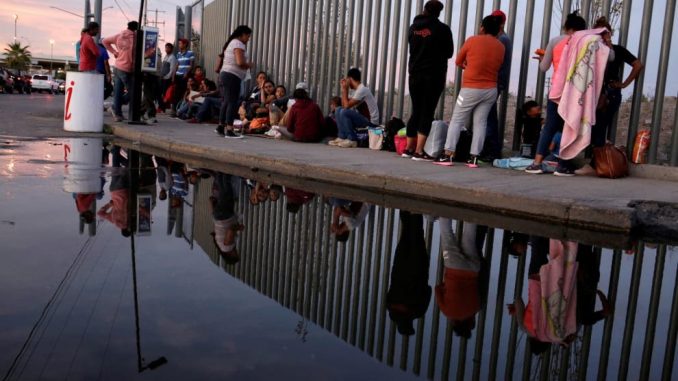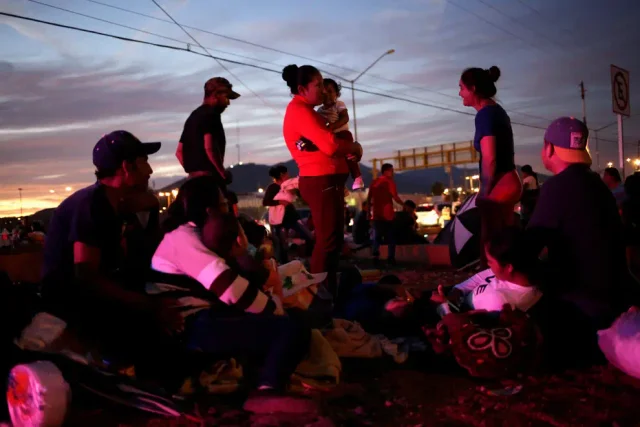
Mexicans fleeing violence camp in a queue to try to cross into the US to apply for asylum at Cordova-Americas border crossing bridge in Ciudad Juarez, Mexico.
An increasing number of Mexican asylum-seekers are being sent back by US border authorities to the country from which they are fleeing, attorneys and immigrant advocates say, leaving them in potentially dangerous circumstances as they await the chance to receive protection in the United States.
In the Mexican city of Ciudad Juárez at least 1,000 Mexican asylum-seekers — many of whom are children — are living in makeshift encampments near official border crossings, said Shaw Drake, policy counsel at the Border Rights Center for the ACLU of Texas.
“CBP continues to reject asylum-seekers at ports of entry, including Mexican nationals,” Drake told BuzzFeed News.
For years, Mexican nationals have been among those from all over the world presenting themselves at the US border for their chance to ask for asylum, though in smaller numbers than the thousands seeking refuge from Central American countries. Advocates have long complained that unlike Central Americans, the US was sending Mexicans back to the country from which they were seeking protection, putting them in danger.
Now, Mexican nationals increasingly fleeing cartel violence in the country are being forced to wait at official border crossings in violent cities across from Texas, Drake said. The US, he said, is violating its own laws, as well as international law, by sending Mexican asylum-seekers back to the country they are trying to receive protection from.
“I think CBP understands how illegal it is for the US to turn away Mexicans back into Mexico, but they are doing it anyway,” Drake said of US Customs and Border Protection officials.
In a statement, a CBP spokesperson said it processes undocumented immigrants as quickly as possibly, but that its port of entry facilities aren’t designed to hold hundreds of asylum-seekers at a time. CBP officers at international crossings who usually are the first to encounter asylum-seekers aren’t weighing the validity of their claims, the agency said, but are instead making sure people have proper documentation to enter the US.
“If they do not and there is no space available at the CBP facility they are instructed to wait,” the agency said in a statement. “Every month CBP officers in El Paso are processing hundreds of asylum seekers who claim fear at area ports from a variety of nations.”
CBP said it has redirected resources from vehicle entry lanes in El Paso to increase its ability to process asylum-seekers from Mexico’s Ciudad Juárez, leading to longer wait times for vehicles at the Paso Del Norte port of entry.
“As we have done for several years, when our ports of entry reach capacity, we have to manage the queues and individuals presenting without documents may need to wait in Mexico as CBP officers work to process those already within our facilities,” CBP said.
(snip)
Thousands of Central American immigrants, many of them asylum-seekers, have made their way to the US-Mexico border in recent years, where they have been forced to wait weeks to months before attempting to enter the US for refuge. The number has swelled substantially under the Trump administration’s Migrant Protection Protocols (MPP), which has seen more than 47,000 asylum-seekers sent back while their immigration cases play out in the US.
The practice of turning back asylum-seekers who present themselves at official border crossings is at the center of a 2017 lawsuit filed on behalf of Al Otro Lado, a binational border rights project and legal service provider, and asylum-seekers. The complaint alleges that turning asylum-seekers away is a violation of US and international laws.
A government watchdog report published last week, found that contrary to federal law and agency policy, CBP officers at the Tecate, California, port of entry sent back asylum-seekers already on US soil to Mexico.
Many asylum-seekers cite violence as a reason for seeking protection in the US. More than 23,000 people have been killed in Mexico in the first eight months of 2019, according to data from the Mexican government, a growing figure that at its current rate is expected to surpass the record number of homicides reported in 2018.

Jose Luis Gonzalez / Reuters
Joanna Williams, the director of education and advocacy at the Kino Border Initiative, said there are about 300 Mexicans out of the 700 asylum-seekers on a waiting list in Nogales.
“Mexicans are fleeing persecution in the country that they’re currently in so turning them away is very directly sending them back to their persecutor,” Williams told BuzzFeed News. “Especially for individuals who are fleeing from the particular cartel in control of that area.”
In San Luis Río Colorado in the Mexican state of Sonora there were 874 Mexican asylum-seekers on a wait list out of 1,263 in mid-September.
In Matamoros, a border city in the eastern Mexican state of Tamaulipas, more than 300 Mexicans — about 80 of whom are children — are waiting to ask the US for asylum, said Maria Cordero, senior engagement specialist with the ACLU of Texas. Most of the asylum-seekers are from the southern states of Chiapas and Guerrero, she said, and a majority of them speak an indigenous language.
At another nearby border crossing in Matamoros, a growing encampment is the temporary home to more than 500 mostly Central American asylum-seekers waiting for their turn to seek refuge in the US. Many Cuban asylum-seekers, who tend to have more financial support from family in the US compared to their Central American counterparts, are staying in nearby apartments or hotels but still represent a significant group of immigrants waiting in the area.
“The system, instead of finding solutions, puts up barriers and creates problems on the Mexican side,” Cordero told BuzzFeed News. “It’s a really horrible scene. People are sleeping on the street with babies.”
In recent years, Cordero said, organizations helping immigrants would see Mexican families show up at the border crossing, but in fewer numbers than today.
“They’re waiting at the bridge because they know they shouldn’t be sent back to the country they’re fleeing from and so they hope that at any moment CBP will let them cross,” Cordero said.
*see full story by Buzzfeed News